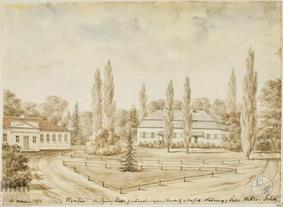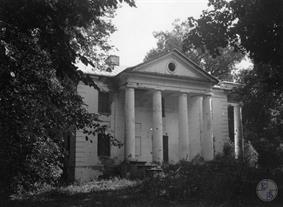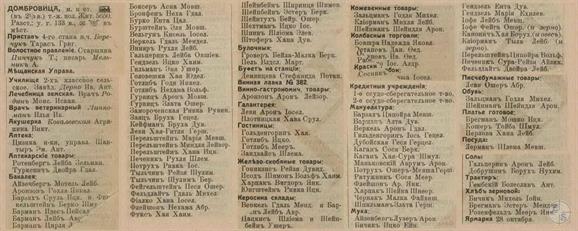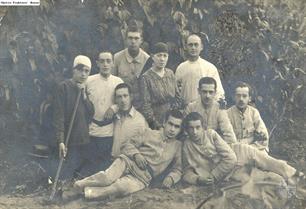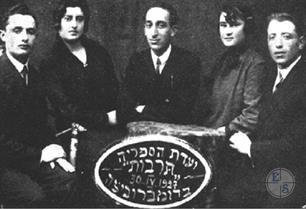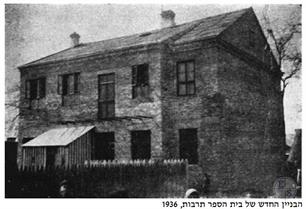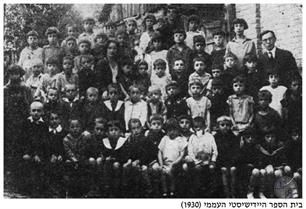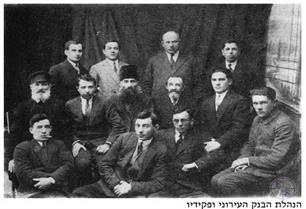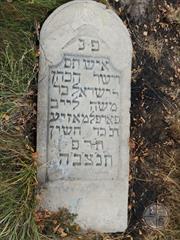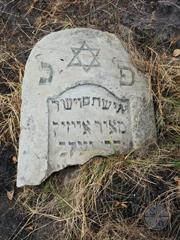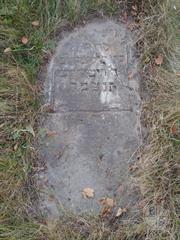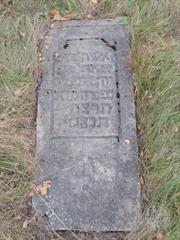Dubrovytsya
Sarny district, Rivne region
Sources:
- Russian Jewish encyclopedia. Translated from Russian by Eugene Snaider
- Jewish encyclopedia of Brockhaus & Efron
- Virtual Shtetl. Berezne - guidebook
- Domborwica Memorial Book, Tel-Aviv, 1964. Sefer Domborwica
- The All South-Western Territory: reference and address book of the Kyiv, Podolsk and Volyn provinces. Printing house L.M. Fish and P.E. Wolfson, 1913
Photo:
- Domborwica Memorial Book
- Ghetto Fighters' House. Members of the HeHalutz in Dubrovytsya
- European Jewish Cemeteries Initiative, Dubrovytsya New Jewish Cemetery. Published by Center for Jewish Art
- Russian Jewish encyclopedia. Translated from Russian by Eugene Snaider
- Jewish encyclopedia of Brockhaus & Efron
- Virtual Shtetl. Berezne - guidebook
- Domborwica Memorial Book, Tel-Aviv, 1964. Sefer Domborwica
- The All South-Western Territory: reference and address book of the Kyiv, Podolsk and Volyn provinces. Printing house L.M. Fish and P.E. Wolfson, 1913
Photo:
- Domborwica Memorial Book
- Ghetto Fighters' House. Members of the HeHalutz in Dubrovytsya
- European Jewish Cemeteries Initiative, Dubrovytsya New Jewish Cemetery. Published by Center for Jewish Art
Dubrovytsya (until 1940 - Dombrovitsa), the city, until 2022 - the district center in the Rivne region. Known from the 12th century. In the 16-18 centuries - the township of Pinsk powiat of Brest Voivodeship as part of the Commonwealth. Since 1793 - as part of the Russian Empire. In the 19th - beginning of the 20th century - the township of the Rivne district of the Volyn province. In 1919–39 - as part of the Volyn Voivodeship of Poland, in 1939–91 - as part of the Ukrainian SSR.
In 1766, 404 Jews lived in Dubrovytsya,
in 1847 - 1910,
in 1897 - 2686 (47.7%),
in 1921 - 2536,
in 1931 - 2739,
In 1937 - 3225 Jews (43.4%).
The earliest records of Jewish presence in Dubrovytsya date back to the beginning of the 16th century. In the 17th century, a small community existed in the town. It belonged to the kehilla in Pinsk.
In the mid-18th century, Jews were granted extensive privileges by the owners of the town. This created favourable conditions for the development of a crafts- and trade-oriented community. In the 19th century, Jewish people constituted the majority of the local population. The proportions changed at the end of the century, but Jews still formed a large community – in 1897, it comprised 2,868 people (47.7% of the town’s population).
In 1766, 404 Jews lived in Dubrovytsya,
in 1847 - 1910,
in 1897 - 2686 (47.7%),
in 1921 - 2536,
in 1931 - 2739,
In 1937 - 3225 Jews (43.4%).
The earliest records of Jewish presence in Dubrovytsya date back to the beginning of the 16th century. In the 17th century, a small community existed in the town. It belonged to the kehilla in Pinsk.
In the mid-18th century, Jews were granted extensive privileges by the owners of the town. This created favourable conditions for the development of a crafts- and trade-oriented community. In the 19th century, Jewish people constituted the majority of the local population. The proportions changed at the end of the century, but Jews still formed a large community – in 1897, it comprised 2,868 people (47.7% of the town’s population).
Jews held the leading position in the local trade and owned numerous manufacturing plants. In terms of religion, the Hasidim of the Karlin-Stolin and Berezne dynasties were initially dominant in the town, but over time more and more ground was gained by the Zionists and the Bund – the latter was active since the beginning of the 20th century.
In 1865, 3 synagogues were in Dubrovytsya, in 1910 - 5 synagogues, including 3 Hasidic, a cemetery with the oldest grave of the 16th century.
The rabbis in Dubrovytsya were: in the 19th century - Yakov-Natan Weissman, until 1900 - Yakov Shapiro (? –1900), in 1901–37 - Yakov Saltsman, in 1918-1942 - Nokhum-Yehoshua Pechnik (? –1942) and Aba Saltsman, who founded the Hasidic court in Dubrovytsya at the end 1930s.
In 1884, a Jewish pogrom occurred in Dubrovytsya.
In October 1915, the Jews of Dubrovytsya were evicted to the internal regions of Russia.
In 1913, Jews owned both pharmacy warehouses, both kerosene warehouses, all 4 hotels, 97 shops (including all 44 grocery, all 14 manufactory).
Two credit society acted.
In 1917, a self-defense squad was created, then a school and a kindergarten were opened with teaching in Hebrew, and a school with teaching in Yiddish.
At the beginning of 1919, the directory troops arranged a pogrom in the township. Another pogrom occurred on July 10, 1919.
In 1865, 3 synagogues were in Dubrovytsya, in 1910 - 5 synagogues, including 3 Hasidic, a cemetery with the oldest grave of the 16th century.
The rabbis in Dubrovytsya were: in the 19th century - Yakov-Natan Weissman, until 1900 - Yakov Shapiro (? –1900), in 1901–37 - Yakov Saltsman, in 1918-1942 - Nokhum-Yehoshua Pechnik (? –1942) and Aba Saltsman, who founded the Hasidic court in Dubrovytsya at the end 1930s.
In 1884, a Jewish pogrom occurred in Dubrovytsya.
In October 1915, the Jews of Dubrovytsya were evicted to the internal regions of Russia.
In 1913, Jews owned both pharmacy warehouses, both kerosene warehouses, all 4 hotels, 97 shops (including all 44 grocery, all 14 manufactory).
Two credit society acted.
In 1917, a self-defense squad was created, then a school and a kindergarten were opened with teaching in Hebrew, and a school with teaching in Yiddish.
At the beginning of 1919, the directory troops arranged a pogrom in the township. Another pogrom occurred on July 10, 1919.
During the period of the Second Polish Republic, Jews once again became the dominant community in Dubrovytsya. According to the 1921 census, 2,536 Jews inhabited the town. They owned 98% of local trade outlets and most of the craft shops.
The local Tarbut school was attended by 280 pupils.
The Zionist circles were active in the town, including the HeHalutz youth movement, which ran a training farm for 300 future settlers in Palestine.
In 1920-30s yeshiva acted it the township.
In 1937, 3,225 Jews lived in Dubrovytsya.
The local Tarbut school was attended by 280 pupils.
The Zionist circles were active in the town, including the HeHalutz youth movement, which ran a training farm for 300 future settlers in Palestine.
In 1920-30s yeshiva acted it the township.
In 1937, 3,225 Jews lived in Dubrovytsya.
World War II and the Holocaust
In September 1939, with the Soviet takeover, trainloads of refugees reached the town, and were again accommodated in the Jews homes and the synagogues. Jewish and Christian refugees were fed equally in the town's Jewish learning house.
During the 2nd world war the Jews of Dąbrowica went through a year of horrific events, beginning on a Tuesday in June 1941, with the Ukrainian population blowing up the Hassidic synagogue, catching 500 of the prominent Jews in town and gathering them in preparation of a welcoming ceremony for the German army. These Jews were tortured, had their beards torn off, and a few were killed. A short while later the town became part of a German supported Ukrainian self-rule. Under the Ukrainian police, the Jews were sent to forced labor, working with manure, and cutting wood, while their property and possessions were taken from them.
A Judenrat was established and a Ghetto. Decrees were given to give in large amounts of gold, fur, and shoes. The Jews of the town assembled trying to keep up with the demands, in makeshift workshops. Jews were told to turn over any good looking daughters, were beaten for refusing to do so, and young girls were kidnapped. The Judenrat was eventually all killed except one man who escaped to the forest. Some of them were burnt alive.
At some time during that year more than 300 Jewish women with their children reached the town from Dwid-Gordok, after the men were all taken to dig defense trenches. A group of men from Dąbrowica investigated and discovered that the men were shot and buried in the trenches, but did not pass this information on to the refugees.
On November 6, 1941, two woman survivors of the massacre of 17,000 Jews at Rowno (Rivne, Ukraine), crawling away after being buried alive, reached Dąbrowica. A short while later a 35-man Gestapo unit entered the town, some of them participants at the Rowno Massacre. A delegation of Jewish rabbis and leaders met the Gestapo, who seemingly were willing to receive money, furniture and food allowing the Jewish population to live. 35 Jews most of them youth were held in prison and tortured. Food for the Jews was rationed down to 800 grams of bread per week per person.
Around April 1942 a Ghetto was established in the town for its 4327 Jews. In response to a plea by the Jewish leadership, the Germans allowed for a larger Ghetto than originally planned. The establishment of the Ghetto and response to the plea were seen as a token for German non lethal plans with the Jews. All gold was to be delivered to the Germans, and the punishment for a Jew holding gold was death. The two old rabbis brought in all their gold, laying an example before the rest of the community, in hope that the Germans would not have further claims.[2]: 200 Jews from neighboring villages were forced into the Ghetto as well. During the deportation, the neighbors snatched the Jews' belongings and openly told the refugees that they would not abide by property agreements that they had made with them. The main synagogue was closed and public prayers were not allowed.
57 Jewish policemen guarded the Ghetto mostly collaborating with the Germans, and an antagonism developed between the Judenrat (Jewish committee) and the Jewish population.
Evidence has been gathered that psychologists and other experts were sent to the town, to see to it that the Jewish population complies with the German decrees without revolting.
A notice was put up calling all Jews to assemble on the second day of Shavuot the Jewish holiday of Pentecost at the cemetery. The main synagogue was opened for prayer on the first day of the holiday, and the Jewish speaker for the German rule explained that it is only for a head count. The Jews were sent home.
In September 1939, with the Soviet takeover, trainloads of refugees reached the town, and were again accommodated in the Jews homes and the synagogues. Jewish and Christian refugees were fed equally in the town's Jewish learning house.
During the 2nd world war the Jews of Dąbrowica went through a year of horrific events, beginning on a Tuesday in June 1941, with the Ukrainian population blowing up the Hassidic synagogue, catching 500 of the prominent Jews in town and gathering them in preparation of a welcoming ceremony for the German army. These Jews were tortured, had their beards torn off, and a few were killed. A short while later the town became part of a German supported Ukrainian self-rule. Under the Ukrainian police, the Jews were sent to forced labor, working with manure, and cutting wood, while their property and possessions were taken from them.
A Judenrat was established and a Ghetto. Decrees were given to give in large amounts of gold, fur, and shoes. The Jews of the town assembled trying to keep up with the demands, in makeshift workshops. Jews were told to turn over any good looking daughters, were beaten for refusing to do so, and young girls were kidnapped. The Judenrat was eventually all killed except one man who escaped to the forest. Some of them were burnt alive.
At some time during that year more than 300 Jewish women with their children reached the town from Dwid-Gordok, after the men were all taken to dig defense trenches. A group of men from Dąbrowica investigated and discovered that the men were shot and buried in the trenches, but did not pass this information on to the refugees.
On November 6, 1941, two woman survivors of the massacre of 17,000 Jews at Rowno (Rivne, Ukraine), crawling away after being buried alive, reached Dąbrowica. A short while later a 35-man Gestapo unit entered the town, some of them participants at the Rowno Massacre. A delegation of Jewish rabbis and leaders met the Gestapo, who seemingly were willing to receive money, furniture and food allowing the Jewish population to live. 35 Jews most of them youth were held in prison and tortured. Food for the Jews was rationed down to 800 grams of bread per week per person.
Around April 1942 a Ghetto was established in the town for its 4327 Jews. In response to a plea by the Jewish leadership, the Germans allowed for a larger Ghetto than originally planned. The establishment of the Ghetto and response to the plea were seen as a token for German non lethal plans with the Jews. All gold was to be delivered to the Germans, and the punishment for a Jew holding gold was death. The two old rabbis brought in all their gold, laying an example before the rest of the community, in hope that the Germans would not have further claims.[2]: 200 Jews from neighboring villages were forced into the Ghetto as well. During the deportation, the neighbors snatched the Jews' belongings and openly told the refugees that they would not abide by property agreements that they had made with them. The main synagogue was closed and public prayers were not allowed.
57 Jewish policemen guarded the Ghetto mostly collaborating with the Germans, and an antagonism developed between the Judenrat (Jewish committee) and the Jewish population.
Evidence has been gathered that psychologists and other experts were sent to the town, to see to it that the Jewish population complies with the German decrees without revolting.
A notice was put up calling all Jews to assemble on the second day of Shavuot the Jewish holiday of Pentecost at the cemetery. The main synagogue was opened for prayer on the first day of the holiday, and the Jewish speaker for the German rule explained that it is only for a head count. The Jews were sent home.
In the last three months of Ghetto, the Germans put up signs that Jews had poisoned the wells. Christian posters called for the demise of the Jews who were the cause for the fall of Egypt, Babylon, Assyria, Greece, Chmelnitzki and Petliura.
50 Jewish children returning from forced labor were found with potatoes in their pockets and beaten. Testimony about the massacre of 65 Jewish slave workers from Refalovka at Chestorisk, shot after the first train crossed the bridge they had just finished building, reaches Dubrowica, and about the mass murder of 500 Jews the remnants of Ghetto Pohost, rounded up at Moroczna. Special agents were sent in to the Ghetto to calm the residents and contest the rumors that the Jewish of Kuritz had been killed.
Two weeks before the end, the Jews of Dubrowica learned of the massacre in death trenches of all the Jews of the nearby Rozhichecz, many of them buried alive. Again an agent was sent to disprove the rumors, and claim that the Rozhichecz massacre never happened.
The unit of Ukrainian militia in Dubrowica had participated in the massacre of Jews at Rozhichecz, Kobel and other places, two weeks before. One week before, some of the policemen intended to shoot Jewish forced labor workers coming back from the forest. The policemen were supposedly punished by the German commander, giving the Jews an extra false sense of security.
After a week of enlisting, on Tuesday evening, the 25 of August 1942, a night of almost full moon, three days of the Dubrovytsa Jews' deportation began. A truck with armed German soldiers reached the Ghetto along with a large group of Ukrainian militia men, who surrounded the Ghetto.
Several Jews committed suicide. During the night loud singing and dancing was heard from Ukrainian owned houses in the town. Several failed breakouts ensued. Some 20 or 30 Jews were able to reach the forest that night. One man was shot. Most were caught and imprisoned.
On the morning of the 26th of August, about 4300 Jews marched up to the Judenrat headquarters. 40 German soldiers with white gloves kept the order, setting the Jews in groups according to alphabetical order of their last names. Hundreds of Ukrainian armed militia men stood along the way. A large crowd of Ukrainian citizens with wagons stood at the gate, waiting to take part in the looting. The Judenrat and Jewish police assembled next to the Germans.
The (non-Jewish) chief of the Ukrainian militia spoke Yiddish, quoted verses from the bible, and told the Jews that they would receive "the full redemption", and would be transferred to a larger and better Ghetto.
The first few groups of Jews reached the train station and were stuffed into windowless cattle cars. The rest of the groups realized this was a death trap, and began running away. Shots were heard inside the train station, and the march disassembled. Many of the escaping Jews were shot, or killed by Ukrainians when found. 800 Jews escaped and reached Ghetto Wiesock. They were murdered two weeks later when that Ghetto was liquefied. The trains took the Jews to Serney where they were immediately shot in trenches prepared for them. About 250 Jews escaped to the forest. No more than 50 of them survived the war.
After 1945, a cinema was opened in the premises of the former Great synagogue, in two other synagogues - a working club and a workshop. In the late 1940s - early 1950s minyan gathered in the house of Yeshua Fishman on Saturdays and holidays, for which the Torah scroll was bought in the historical museum.
50 Jewish children returning from forced labor were found with potatoes in their pockets and beaten. Testimony about the massacre of 65 Jewish slave workers from Refalovka at Chestorisk, shot after the first train crossed the bridge they had just finished building, reaches Dubrowica, and about the mass murder of 500 Jews the remnants of Ghetto Pohost, rounded up at Moroczna. Special agents were sent in to the Ghetto to calm the residents and contest the rumors that the Jewish of Kuritz had been killed.
Two weeks before the end, the Jews of Dubrowica learned of the massacre in death trenches of all the Jews of the nearby Rozhichecz, many of them buried alive. Again an agent was sent to disprove the rumors, and claim that the Rozhichecz massacre never happened.
The unit of Ukrainian militia in Dubrowica had participated in the massacre of Jews at Rozhichecz, Kobel and other places, two weeks before. One week before, some of the policemen intended to shoot Jewish forced labor workers coming back from the forest. The policemen were supposedly punished by the German commander, giving the Jews an extra false sense of security.
After a week of enlisting, on Tuesday evening, the 25 of August 1942, a night of almost full moon, three days of the Dubrovytsa Jews' deportation began. A truck with armed German soldiers reached the Ghetto along with a large group of Ukrainian militia men, who surrounded the Ghetto.
Several Jews committed suicide. During the night loud singing and dancing was heard from Ukrainian owned houses in the town. Several failed breakouts ensued. Some 20 or 30 Jews were able to reach the forest that night. One man was shot. Most were caught and imprisoned.
On the morning of the 26th of August, about 4300 Jews marched up to the Judenrat headquarters. 40 German soldiers with white gloves kept the order, setting the Jews in groups according to alphabetical order of their last names. Hundreds of Ukrainian armed militia men stood along the way. A large crowd of Ukrainian citizens with wagons stood at the gate, waiting to take part in the looting. The Judenrat and Jewish police assembled next to the Germans.
The (non-Jewish) chief of the Ukrainian militia spoke Yiddish, quoted verses from the bible, and told the Jews that they would receive "the full redemption", and would be transferred to a larger and better Ghetto.
The first few groups of Jews reached the train station and were stuffed into windowless cattle cars. The rest of the groups realized this was a death trap, and began running away. Shots were heard inside the train station, and the march disassembled. Many of the escaping Jews were shot, or killed by Ukrainians when found. 800 Jews escaped and reached Ghetto Wiesock. They were murdered two weeks later when that Ghetto was liquefied. The trains took the Jews to Serney where they were immediately shot in trenches prepared for them. About 250 Jews escaped to the forest. No more than 50 of them survived the war.
After 1945, a cinema was opened in the premises of the former Great synagogue, in two other synagogues - a working club and a workshop. In the late 1940s - early 1950s minyan gathered in the house of Yeshua Fishman on Saturdays and holidays, for which the Torah scroll was bought in the historical museum.

- Home
- Shtetls
- Vinnytsia region
- Volyn region
- Dnipro region
- Donetsk region
- Zhytomyr region
- Zakarpattia region
- Zaporizhzhia region
- Ivano-Frankivsk region
- Kyiv region
- Kropyvnytskyi region
- Luhansk region
- Lviv region
- Mykolayiv region
- Odessa region
- Poltava region
- Rivne region
- Sumy region
- Ternopil region
- Kharkiv region
- Kherson region
- Khmelnytskyi region
- Chernihiv region
- Chernivtsi region
- Cherkasy region
- Crimea
- Synagogues
- Cemeteries
- Objects & guides
- Old photos
- History
- Contact
Jewish towns of Ukraine
My shtetl
My shtetl
Donate
Jewish towns of Ukraine
